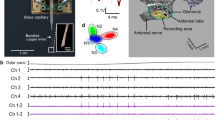Abstract
Prior behavioral and neurophysiological studies provide evidence that the nudibranch mollusk Tritonia orients to the earth’s magnetic field. Earlier studies of electrophysiological responses in certain neurons of the brain to changing ambient magnetic fields suggest that although certain identified brain cells fire impulses when the ambient field is changed, these neuron somata and their central dentritic and axonal processes are themselves not primary magnetic receptors. Here, using semi-intact animal preparations from which the brain was removed, we recorded from peripheral nerve trunks. Using techniques to count spikes in individual nerves and separately also to identify, then count individual axonal spikes in extracellular records, we found both excitatory and inhibitory axonal responses elicited by changes in the direction of ambient earth strength magnetic fields. We found responses in nerves from many locations throughout the body and in axons innervating the body wall and rhinophores. Our results indicate that primary receptors for geomagnetism in Tritonia are not focally concentrated in any particular organ, but appear to be widely dispersed in the peripheral body tissues.



Similar content being viewed by others
References
Beck W, Wiltschko W (1988) Magnetic factors control the migratory direction of pied flycatchers (Ficedula hypoleuca Pallas). In: Ouellet H (ed) Acta XIX Congr Int Ornithol Vol II. University of Ottawa Press, Ottawa, pp 1955–1962
Blakemore RP (1975) Magnetotactic bacteria. Science 190:377–379
Cain SD, Wang JH, Lohmann KJ (2006) Immunocytochemical and electrophysiological analyses of magnetically sensitive neurons in the mollusk Tritonia diomedea. J Comp Physiol A 192:235–245
Hein CM, Engels S, Kishkinev D, Mouritsen H (2011) Robins have a magnetic compass in both eyes. Nature 471:E11–E13
Lohmann KJ (1991) Magnetic orientation by hatchling loggerhead sea turtles (Caretta caretta). J Exp Biol 155:37–49
Lohmann KJ (2010) Animal behaviour: magnetic-field perception. News and views Q&A. Nature 464:1140–1142
Lohmann KJ, Willows AOD (1987) Lunar-modulated geomagnetic orientation by a marine mollusk. Science 235:331–334
Lohmann KJ, Willows AOD, Pinter RB (1991) An identifiable molluscan neuron responds to changes in earth-strength magnetic fields. J Exp Biol 161:1–24
Marhold S, Burda H, Kreilos I, Wiltschko W (1997) Magnetic orientation in the common mole-rat from Zambia. In: Orientation and navigation—birds, humans and other animals. Royal Instit of Navig, Oxford, 5-1–5-9
Marhold S, Beiles A, Burda H, Nevo E (2000) Spontaneous directional preference in a subterranean rodent, the blind mole-rat, Spalax ehrenbergi. Folia Zoologica 49:7–18
Mather JG, Baker RR (1981) Magnetic sense of direction in woodmice for route-based navigation. Nature 291:152–155
Phillips JB (1986) Magnetic compass orientation in the eastern red-spotted newt (Notophthalmus viridescens). J Comp Physiol A 158:103–109
Phillips JB, Sayeed O (1993) Wavelength-dependent effects of light on magnetic compass orientation in Drosophila melanogaster. J Comp Physiol A 172:303–308
Phillips JB, Adler K, Borland SC (1995) True navigation by an amphibian. Anim Behav 50:855–858
Popescu IR, Willows AOD (1999) Sources of magnetic sensory input to identified neurons active during crawling in the marine mollusc Tritonia diomedea. J Exp Biol 202:3029–3036
Quinn TP, Brannon EL (1982) The use of celestial and magnetic cues by orienting sockeye salmon Oncorhynchus nerka smolts. J Comp Physiol A 147:547–552
Quinn TP, Merrill RT, Brannon EL (1981) Magnetic field detection in sockeye salmon. J Exp Zool 217:137–142
Walcott C, Green RP (1974) Orientation of homing pigeons altered by a change in the direction of an applied magnetic field. Science 184:180–182
Walker MM, Bitterman ME (1989) Attached magnetics impair magnetic field discrimination by honeybees. J Exp Biol 141:447–451
Walker MM, Diebel CE, Haugh CV, Pankhurst PM, Montgomery JC, Green CR (1997) Structure and function of the vertebrate magnetic sense. Nature 390:371–376
Wang JH, Cain SD, Lohmann KJ (2004) Identifiable neurons inhibited by Earth-strength magnetic stimuli in the mollusk Tritonia diomedea. J Exp Biol 207:1043–1049
Willows AOD (1999) Shoreward orientation involving geomagnetic cues in the nudibranch mollusc Tritonia diomedea. Mar Fresh Behav Physiol 32:181–192
Wiltschko W, Wiltschko R (1972) Magnetic compass of European robins. Science 176:62–64
Wiltschko W, Wiltschko R (2005) Magnetic orientation and magnetoreception in birds and other animals. J Comp Physiol A 191:675–693
Wiltschko W, Traudt J, Gunturkun O, Prior H, Wiltschko R (2002) Lateralization of magnetic compass orientation in a migratory bird. Nature 419:467–470
Acknowledgments
We thank the University of Washington, Friday Harbor Laboratories for animal care facilities in all phases of this work. GAP was supported by NSF IBN-0416328 to AODW.
Author information
Authors and Affiliations
Corresponding author
Rights and permissions
About this article
Cite this article
Pavlova, G.A., Glantz, R.M. & Dennis Willows, A.O. Responses to magnetic stimuli recorded in peripheral nerves in the marine nudibranch mollusk Tritonia diomedea . J Comp Physiol A 197, 979–986 (2011). https://doi.org/10.1007/s00359-011-0659-0
Received:
Revised:
Accepted:
Published:
Issue Date:
DOI: https://doi.org/10.1007/s00359-011-0659-0




